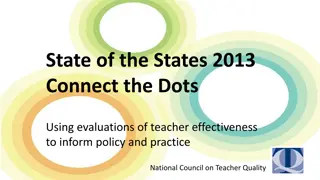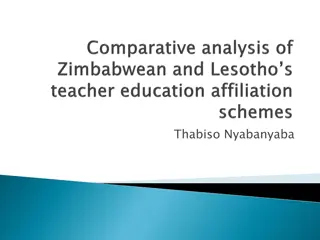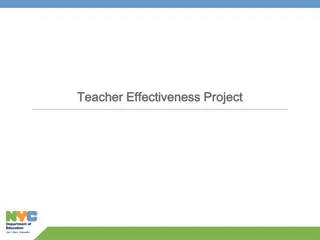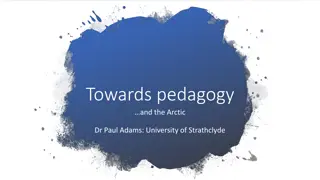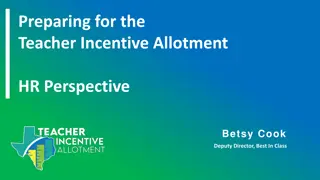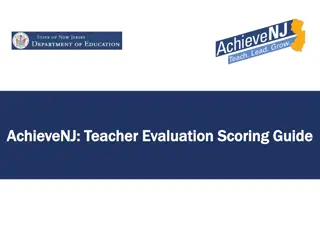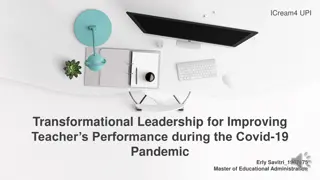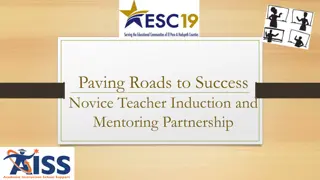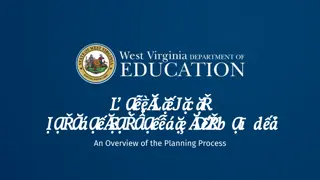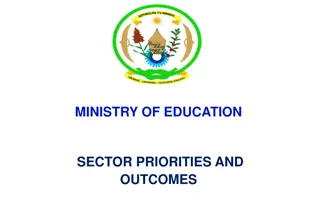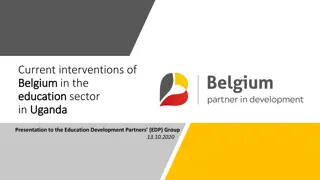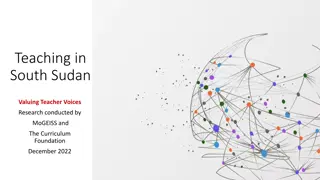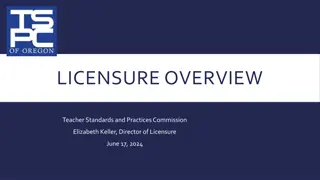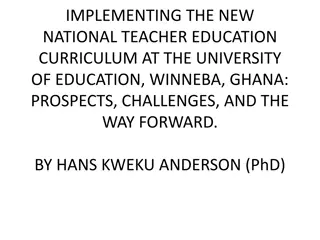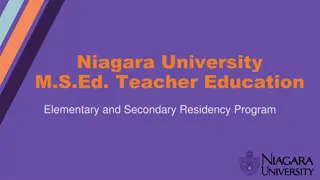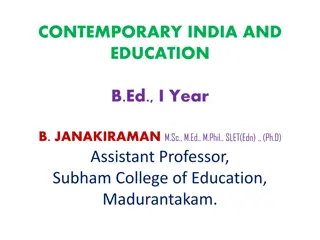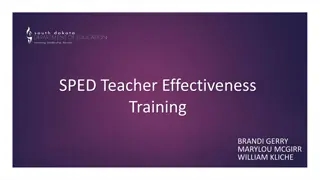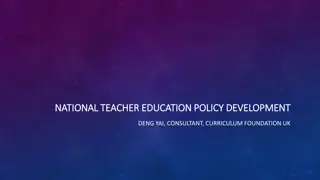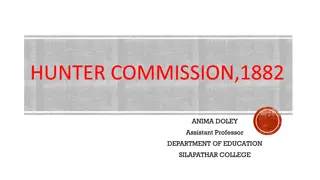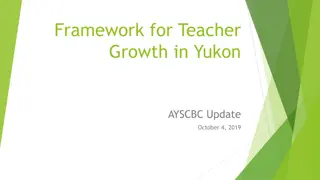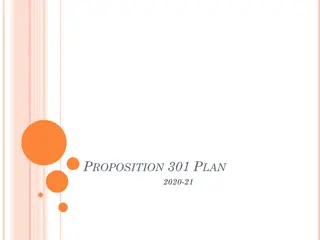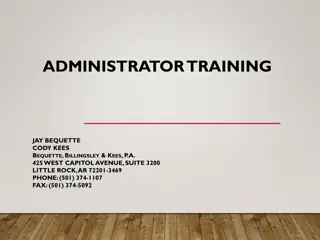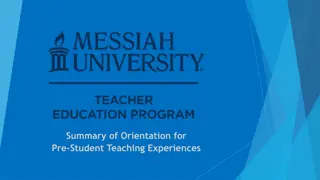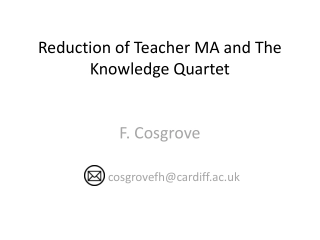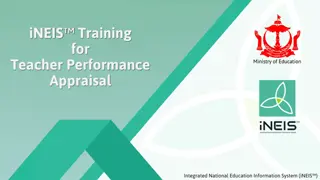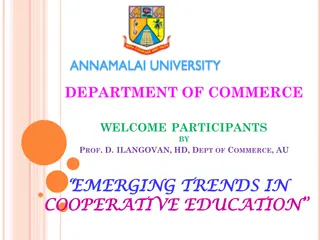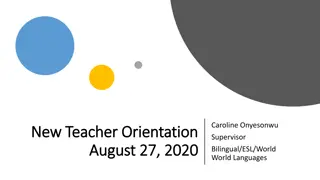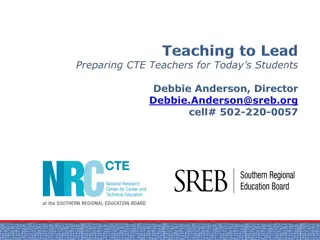Understanding Teacher Education: A Comprehensive Overview
Teacher education encompasses the policies, procedures, and training designed to equip prospective teachers with the knowledge, skills, attitudes, and behaviors needed to excel in the classroom and the wider educational community. It involves imparting subject matter knowledge, pedagogic skills, child psychology understanding, fostering positive teaching attitudes, building self-confidence, and utilizing instructional resources effectively. The National Council for Teacher Education defines teacher education as a program for preparing individuals to teach from pre-primary to higher education levels.
Download Presentation

Please find below an Image/Link to download the presentation.
The content on the website is provided AS IS for your information and personal use only. It may not be sold, licensed, or shared on other websites without obtaining consent from the author. Download presentation by click this link. If you encounter any issues during the download, it is possible that the publisher has removed the file from their server.
E N D
Presentation Transcript
Teacher Education Dr.R.Jeyanthi Assistant Professor, Dept of Education, GRI-DU, Gandhigram.
Teacher Education-Intro Teacher education or teacher training refers to the policies, provision designed to equip (prospective) teachers with the knowledge, behaviors, and skills they require to perform their tasks effectively in the classroom, school, and wider professionals who engage in this activity are called teacher educators contexts, teacher trainers). procedures, and attitudes, community. The (or, in some
TEACHER EDUCATION Teacher education refers to the policies and procedures designed to equip prospective teachers with the knowledge, attitudes, behaviors and skills they require to perform their tasks effectively in the classrooms, schools and wider community.
Teacher Education-Meaning According to Goods Dictionary of Education, Teacher education means, all the formal and non-formal activities and experiences that help to qualify a person to assume responsibilities of a member of the educational profession or to discharge his responsibilities more effectively.
Teacher Education-Definition A programme of education, research and training of persons to teach from preprimary to higher education level. -(National Council for Teacher Education)
Teacher Education-Definition The National Council for Teacher Education has defined teacher education as A programme of education, research and training of persons to teach from pre-primary to higher education level. Teacher education is a programme that is related to the development of teacher competence that would enable and empower the teacher to meet the requirements of the profession and face the challenges therein. proficiency and
OBJECTIVES OF TEACHER EDUCATION Imparting an adequate knowledge of the subject matter Equipping the prospective teachers with necessary pedagogic skills Enabling the teacher to acquire understanding of child psychology Developing proper attitudes towards teaching Developing self-confidence in the teachers Enabling teachers to make proper use of instructional facilities
IMPORTANCE OF TEACHER TRAINING "If you educate a boy, you educate one individual. If you educate a girl, you educate the whole family and if you educate a teacher, you educate the whole community."
IMPORTANCE OF TEACHER TRAINING (i) Better Understanding of the Student (ii) Building Confidence (iii) Using Methodology of Teaching (iv) Building favorable Attitude (v) Familiarizing with the Latest in Education (vi) Making familiar with School organization (vii) Creating social Insight (viii) Improving Standards (ix) Training for Democracy
TYPES OF TEACHER EDUCATION PROGRAMMES Pre-primary teacher education[higher secondary, 1 yr] Primary teacher education[higher secondary, 2 yrs ] Secondary teacher education[graduation, 1 yr] Higher education program[1 yr M.Ed. Course, 2yr M. A in Education, 2 yr Ph.D.course after M.Ed./M.A. ] Vocational Teachers Training[1 yr Diploma in Physical Education (DPE), Training courses to prepare teachers of Music, Dancing, Painting and Fine Arts, 1 yr training course to prepare teachers for Home Science, Certificate courses in Arts & Crafts]
CHALLENGES IN TEACHER EDUCATION 1. Several types of teacher education institutions thereby lacking in uniformity. 2. Poor standards with respect to resources for colleges of education. 3. Unhealthy financial condition of the colleges of education 4. Incompetent teacher educators resulting in deficiency of scholars. 5. Improper selection of the candidates (student teachers) to be admitted.
CHALLENGES IN TEACHER EDUCATION 6. Traditional curriculum and teaching methods of teaching in the teacher education programme. 7. Haphazard and improper organization of teacher education. 8.Unplanned and insufficient activities. 9. Inadequate duration of the teacher programme. 10. Feedback mechanisms lacking. co-curricular
TEACHER EDUCATION IN INDIA Teacher education is provided by several Universities, affiliated colleges, private and open Universities in India. The Teacher Education Policy in India has evolved over time and is based on recommendations contained in various Reports of Committees/Commissions Education: the Kothari Commission (1966) the Chattopadyay Committee (1985) the National Policy on Education (NPE 1986/92) Acharya Ramamurthi Committee (1990) Yashpal Committee (1993) on
TEACHER EDUCATION IN INDIA and the National Curriculum Framework (NCF, 2005) The Right of Children to Free and Compulsory Education (RTE) Act operational from 1st April, 2010, has important implications for teacher country. 2009, which became education in the
AIMS OF TEACHER EDUCATION IN INDIA 1. To enhance the institutional capacity available at present for ensuring the adequate supply of trained teachers for education. 2. To utilize all possible kinds of institutions for inservice training of the existing cadre at all levels. 3. To bring about synergy between institutional structures operating at different levels all levels of school
AIMS OF TEACHER EDUCATION IN INDIA 4. To facilitate co-operation and collaboration between institutes of teacher training and colleges. 5. To envision a comprehensive model of teacher education. 6. To prepare a curriculum policy and framework for teacher education which is consistent with the vision of NCF
LEGAL AND INSTITUTIONAL FRAMEWORK Broad policy and legal framework on teacher education is provided by the Central Government Implementation of various program and schemes are undertaken largely by state governments. Within the broad objective of improving the learning achievements of school children, the twin strategy is to: Prepare teachers for the school system (pre-service training). Improve capacity of existing school teachers (in-service training).
REFORMS IN TEACHER EDUCATION 1. Revision of the Centrally Sponsored Scheme of Teacher Education. 2. Modification in Centre-State financial sharing pattern, from the existing 100% central assistance to sharing pattern in the ratio of 75:25 for all States/UTs (90:10 for NER States) 3. Continuation of support to SCERTs/SIEs Strengthening and re-structuring of SCERTs, Training for Educational Administrators, including Head Teachers. 4. Orientation / Induction Training to Teacher Educators 5. Continuation of support establishment of new CTEs to CTEs and
REFORMS IN TEACHER EDUCATION 4. Continuation of support to IASEs and establishment of new IASEs 5. Continuation of support to and restructuring of DIETs 6. Establishment of Block Institutes of Teacher Education (BITEs) for augmenting Teacher Education capacity in SC/ST and minority concentration areas 7. Professional Development of Teacher Educators 8. Technology in Teacher Education 9. Public-Private Partnership (PPP) in teacher education
REFORMS IN TEACHER EDUCATION National Curriculum Framework on Teacher Education highlighted specific objectives, broad areas of study in terms of theoretical and practical learning, and curricular transaction and assessment strategies for the various initial teacher education programmes. outlines the basic issues that should guide formulation of all programmes of these courses. recommendations on the approach and methodology of inservice teacher training programmes outlined a strategy for implementation of the Framework.
REFORMS IN TEACHER EDUCATION The Framework has some important dimensions of the new approach to teacher education: Reflective practice to be the central aim of teacher education Student-teachers should be provided opportunities for self learning, reflection, assimilation and articulation of new ideas Developing capacities for self-directed learning and ability to think, be critical and to work in groups Providing opportunities to student-teachers to observe and engage with children, communicate with and relate to children.
HENCE THERE WOULD BE A MAJOR SHIFT FROM Teacher centric, stable designs. Learner centric, flexible process Teacher direction and decisions. Learner autonomy Teacher guidance and monitoring. Facilitates, support and encourages learning Active participation in learning Passive reception in learning. Knowledge as "given" and fixed. Knowledge as it evolves and created Multiple and divergent exposure Multifarious, continuous Multidisciplinary, educational focus Linear exposure. Appraisal, short, few. Disciplinary focus. Learning within the 4 walls of the classroom. Learning in the wider social context the class room
Teacher Education-Need The American Commission on Teacher Education rightly observes, The quality of a nation depends upon the quality of its citizens. The quality of its citizens depends not exclusively, but in critical measure upon the quality of their education, the quality of their education depends more than upon any single factor, upon the quality of their teacher. In his Call for Action for American Education in the 21st Century in 1996, Clinton indicated that : Every community should have a talented and dedicated teacher in every classroom. We have enormous opportunity for ensuring teacher quality well into the 21st century if we recruit promising people into teaching and give them the highest quality preparation and training .
Reasons for need of TE The need for teacher education is felt due to the following reasons; 1) It is common knowledge that the academic and professional standards of teachers constitute a critical component of the essential learning achieving the educational goals of a nation. conditions for
Reasons for need of TE 2) Educating all children well depends not only on ensuring that teachers have the necessary knowledge and skills to carry out their work, but also that they take responsibility for seeing that all children reach high levels of learning and that they act accordingly. 3) People come to teacher education with beliefs, values, commitments, personalities and moral codes from their upbringing and schooling which affect who they are as teachers and what they are able to learn in teacher education and in teaching.
Reasons for need of TE 4)The National Academy of Education Committee s Report (Darling- Hammond and Bransford, 2005) wrote that : On a daily basis, teachers confront complex decisions that rely on many knowledge and judgement and that can involve high stakes outcomes for students future. To make good decisions, teachers must be aware of the many ways in which student learning can unfold in the context of development, learning differences, cultural influences, and interests and approaches to learning. different kinds of language temperaments, and individual
Reasons for need of TE 5)Teacher education like any other educational intervention, can only work on those professional commitments or dispositions that are modification. While someone s personality, we can reshape attitudes towards the other and develop a professional rather than a personal role orientation towards teaching as a practice. susceptible can t to we remake
Reasons for need of TE 6)The Ministry of Education document Challenge of Education Perspective (1985) has mentioned, Teacher performance is the most crucial input in the field of education. 7)Whatever policies may be laid down, in the ultimate analysis these have to be implemented by teachers as much through their personal example as through teaching learning processes. : A Policy
ICT Enabled Teacher Education The classroom is now changing its look from the traditional one i. e. from communications. Now teachers as well as students participate in classroom discussion. Now Education is based on child centric education. So the teacher should prepare to cope up with different technology for using them in the classroom for making teaching learning implementation of certain student-centric methodologies such as project-based learning which puts the students in the role of active researches and technology becomes the appropriate tool. ICT has enabled better and swifter communication; presentation of ideas more effective and relevant way. It is an effective tool for information acquiring-thus students are encouraged to look for information from multiple sources and they are now more informed then before. So for this reason ICT is very much necessary for Teacher Education. one way to two way interested. For effective
Recent Trends in Teacher Education Now-a-days new trends in teacher education are Inter-disciplinary Approach, courses, orientation Teaching, Micro Teaching, Instruction, Team Teaching are also used in teacher education. Now-a-day Action Research also implemented in Teacher Education. ICT acts as the gateway information and helps teachers to be updated. It creates awareness of instructional methodologies, mechanism etc. for professional development. Correspondence etc. Simulated Programmed courses to the world of innovative trends evaluation in
Strategies for applying ICT in Teacher Education 1. Providing adequate infrastructure and technical support. 2. Applying ICT in all subjects. 3. Applying new Pre-service teacher Education curriculum. 4. By using application software, using multimedia, Internet e-mail, communities, understanding system software.
Role of ICT in Teacher Education 1. ICT helps teachers in both pre-service and in-Service teachers training. 2. ICT helps teachers to interact with students. 3. It helps them in preparation their teaching, provide feedback. 4. ICT also helps teachers to access with institutions and Universities, NCERT, NAAC, NCTE and UGC etc. 5. It also helps in effective use of ICT software and hardware for teaching learning process. 6. It helps in improve Teaching skill, helps in innovative Teaching.
Role of ICT in Teacher Education 7. It helps in effectiveness of classroom. 8.It also helps in improving professional Development and Educational management as well as enhances Active Learning of teacher Trainees. 9. It is now replacing the ancient technology. As we know now-a day s students are always have competitive mind. So teacher must have the knowledge of the subject. This can be done through ICT. 10.ICT helps teachers in preparation for teaching. In order to introduce ICT in pre-service teacher education different methods and strategies are applied. 11.Different tools are used such as word processing, Database, Spreadsheet etc.
Role of ICT in Teacher Education 12. Various technology based plans are used to help the teachers for their practice teaching. 13. ICT prepares teacher for the use of their skills in the real classroom situation and also make students for their future occupation and social life. 14. ICT used as an assisting tool for example while making assignments, communicating, documentation, and conducting research. 15. Typically, ICT is used independently from the subject matter. collecting data &
Role of ICT in Teacher Education 16. ICT as a medium for teaching and learning. It is a tool for teaching and learning itself, the medium through which teachers can teach and learners can learn. 17. It appears in many different forms, such as drill and practice exercises, in simulations and educational networks.
Role of ICT in Teacher Education 19.It removes the traditional method of teaching and prepare teacher to apply modern method of teaching. 20. ICT is plays an important role in student evaluation. 21. ICT is store house of educational institution because information can safely store through ICT. all educational
Role of ICT in Teacher Education 22. ICT helps Teacher to communicate properly with their students. So ICT bridge the gap between teacher and students. 23. ICT helps Teacher to pass information to students within a very little time. 24. ICT helps Teacher to design educational environment. 25. ICT helps Teacher to identify creative child in educational institute.
Historical Development of Teacher Education In India Tagore said, A teacher can never truly teach unless he is still learning himself. A lamp can never light another lamp unless it continues to burn its own flame. The Education Commission (1964-66) professed, The destiny of India is now being shaped in her classrooms . The National Policy on Education 1986 emphasize: The status of the teacher reflects the socio-cultural ethos of the society; it is said that no people can rise above the level of its teachers . Teacher education programme starts molding from the ancient education system and till the present system of education according to the global and local needs of the Indian society.
Historical Development of Teacher Education In India Introduction: Good s dictionary of Education defines Teacher Education as All formal and informal activities and experiences that help to qualify to a person to assume the responsibility as a educational profession or to discharge his responsibility most effectively . member of the
The history of Indian teacher education 1. Ancient and Medieval Period (2500 B.C. to 500 B.C.) 2. Buddhist Period (500 B.C. to 1200 A.D.) 3. Muslim Period (1200 A.D. to 1700 A.D.) 4. British Period (1700 A.D. to 1947 A.D.) 5. Teacher education in independent India (1947 up to this date).
Teacher Education in Ancient & Pre Independence Era. Ancient & Medieval Period(2500BCto500BC) This monitorial system, which was a method of inducting pupils to the position of teachers, was the contribution of the ancient education system. Teaching in the Upanishadic period was known for the personal attention paid to the student. There was an intimate relationship between the teacher and the disciple. The freedom to accept a disciple rested with the teacher, but once he accepted a disciple it became his moral duty to see that the disciple grew. Similarly, a disciple or student had the freedom to choose his teacher. Knowledge was transmitted orally and explanation was one of the important methods of teaching. The methods used by teachers were emulated and adopted by over from one generation of teachers to another. The transmission of methods through initiation and repetition continued. the disciples and handed
Buddhist Period (500 B.C. to 1200 A.D.) The formal system of teachers training emerged during this period. As the importance of teacher education was recognized it got an expansion. The monastic system which was an important feature of Buddhism required that every novice on his admission should place himself under the supervision and guidance of a preceptor (Upajjhaya). The disciple would 'choose an upajjhaya with much care and showed him the utmost respect. The upajjhaya, on his part, had much responsibility to the novice, the Saddhiviharika. He was to offer spiritual help and promote learning through religion among the disciples by teaching, by putting question to him, by exhortation, by instruction. The teacher was to look after the disciple fully. The teachers employed other methods besides oral recitation such as exposition, debate, discussion, question- answer, use of stories and parables. In Vihars and monasticschools, Hetu- Vidya or the inductive method was adopted and the intellect of the disciple was trained through it. The subject Logic was introduced which helped in sharpening the intellect of the learner.
Muslim Period (1200 AD to 1700 AD): During this period there was no formal system of teacher training. In the holy Koran, education is urged as a duty and in Muslim countries, education was held in high esteem. Education was public affair. The Mohammedan rulers in India founded schools (Madrassahs) and libraries in their dominions. In the Maktab, often attached to a mosque, the students received instruction in the Koran which they had to recite, and reading, writing and simple arithmetic was also taught. The medium of "instruction was Persian but the study of Arabic was compulsory. (Maktabs), Colleges
Muslim Period (1200 AD to 1700 AD): In Madrassahs the course included grammar, logic, theology, metaphysics, literature, jurisprudence and sciences. The teachers teaching in the Maktabs were mostly moulvis, but in the Madrassahs scholarly persons were employed. The method of teacher preparation was mostly initiation of what the old teachers practiced. Good and experienced teachers with a discerning eye identified able students and appointed them tutors to look after and teach the junior students in their absence. Thus the monitorial system was in vogue during the medieval times too and was the method of preparing the future teachers. The teachers were held in high esteem and were respected by the society and their students. Cramming and memorising were prevalent during this period. The method of teaching was oral. The teachers adopted the lecture method. Students were encouraged to consult books. Practicals were also conducted in practical subjects like medicine. Analytical and inductive methods were also used to each subject like religion, logic, philosophy and politics.
British Period (1700 AD to 1947 AD): The Britishers changed the above educational system according to their own system, their need and philosophy. Advanced system of education was incorporated. Before the arrival of the Britishers in India the European Missionaries first started scholars and later initiated teacher training institutions. The Danish Missionaries established a normal school for the training of teachers at Serampur near Calcutta. In Madras Dr. Andrew Bell started the experiment of Monitorial System which formed the basis of teacher training programme for the time being. It was used in England and known as Bell-Lancaster system.
British Period (1700 AD to 1947 AD): Mr. Campbell, Collector of Bellary, in his Minute dated 17th August 1823, commended this system by which the more advanced scholars are asked to teach the less advanced and this was well received in England. Sir Munro, in his Minute dated 13 December 1823, gave some ideas for the improvement of the education of teachers. He suggested an increase in their allowance and different types of syllabi for Hindu and Muslim teachers.
British Period (1700 AD to 1947 AD): In June 1826, the first normal school was started in Madras management and with the finances of the British government. Initially it prepared teachers for the district schools. normal school developed into the Presidency College. In 1847, in Bombay a normal school was started in the Elphinstone Institution and in 1849, Calcutta too had a normal school. under the
Teacher Education in Pre Independent India Monitorial System (1880) Wood's Despatch (1854) Lord Stanley's Despatch (1859) Government of India Resolution on Education Policy (1904) The Government of India Resolution on Education Policy (1913). Calcutta University Commission (1917-19) The Hartog Committee (1929) The Abbott - Wood Report (1937) The Sargent Report (1944)
Teacher Education in Pre Independent India Monitorial System (1880) In India, the idea of formal teacher training originated out of an indigenous technique, called Monitorial System . It was based on the principle of mutual instruction. The whole class was splitted into a number of small groups and by placing each group under the charge of a brilliant pupil, called monitor. Teacher s Training Schools The first formal teacher s training School in India was set up at Serampur in Bengal in the name of Normal School by Carey, Marshman and Ward in 1793. In Bombay, the Native Education Society trained a number of teachers for the improvement of teaching in primary schools. In Bengal the Calcutta School Society did pioneering work for the training of teachers for indigenous schools. The Ladies Society of Calcutta started a training class for training women teachers in the Calcutta Central School for girls. A number of government training schools were also set up in the first half of the nineteenth century.
Wood's Despatch -(1854) The Wood's Despatch (popularly known as Magna Charta of English Education in India), an important educational document was released on 19July, 1854. It was rightly been called the most important document on English education in India. It gave some very valuable suggestions for the improvement of the education of teachers. It suggested that allowances be given to persons who possess and aptness for teaching and who are willing to devote themselves to the profession of school master. The establishment of training schools in India. Despatch urged the



